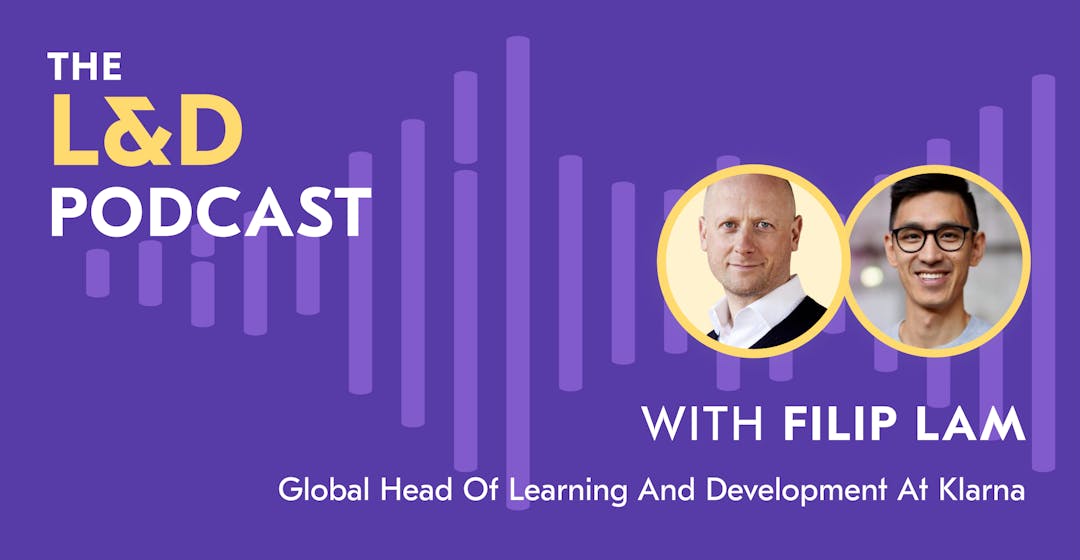
Driving Better Learning Outcomes with Smart Tech and Automation: An Expert Interview with Filip Lam
What is the secret sauce to learning experience design?
The answer: performance orientation. This is why expert Guy Wallace and I have teamed up to interview L&D leaders who have made their own pivot to performance. In a series of seven sessions, we hear how they have driven better results for both organizations and employees.
For the fifth episode, we speak with Filip Lam, Head of L&D at Klarna, about how his performance-oriented approach, coupled with smart technology, helps him move quickly and demonstrably add value whilst almost eliminating administration with automation.
Filip has worked at Swedish FinTech, Klarna, for a little over six years. Previous to that, he worked as a management consultant for a couple of years where he was mostly focused on developing leaders and salespeople.
Read on to hear how Filip made his pivot to performance orientation, and find out how investing in training leads to greater impact.
Boosting learning outcomes with performance-orientated L&D
Filip has been creating L&D programs that change outcomes in organizations. “That requires so much more than just having a strategic approach,” he explains, “but requires you to do the work as well. So, that's why I made the switch.”
Filip’s experience as a health consultant, entrepreneur, and in-house L&D leader led him to make two clear observations about how people learn and how they use the knowledge they’ve acquired to improve their performance. First, it is possible to teach yourself either through mentoring, books, or online resources to improve performance. Second, Filip found that you have to be laser-focused on what makes a difference. The main job is finding the difference between the behaviors, skills, and mindsets of the below-average people and the top performers.
“Do you know the difference between those?” asks Filip. “Unless you ask for those metrics, you can never really build programs that are highly targeted. And that means you are creating something that you believe will have an effect.”
When transforming a business, Filip has found that your first instinct isn’t to improve somebody’s resilience towards stress–it’s to boost performance through understanding how much training is really needed. Similar to how an athlete is willing to go to a Monday session as they know it leads to better performance.
“But if I told the athlete, ‘Okay, you have an Olympic tournament in six months, let's watch some fun videos’, that's not going to work. They already know six months ahead that every single minute has to be planned. Some of it has to be training. Some of it has to be performance.”
Looking for more expert L&D insights? Check out our ebook on how the right L&D strategy can help your company scale.

You have questions–the experts have the answers
By providing your contact info, you agree to receive communications from 360Learning. You can opt-out at any time. For details, refer to our Privacy Policy.
Your first instinct isn’t to improve somebody’s resilience towards stress–it’s to boost performance through understanding how much training is really needed.
Filip went on to break this down with one particular sales training example.
Filip has found, when working with salespeople, if your program isn’t actually helping them close sales, no one’s going to want to take your training. “But if you can show and convince them what they will do will improve their sales,” says Filip, “they will fight for a spot in your training program. You don't need to convince anyone.”
Working with salespeople taught Filip that once you move to a central L&D position, you need to keep that laser focus on taking the organization’s strategy and translating it into human behavior.
But making that move requires data. “And if you don't know what the data is, it's going to be very hard to decide how to prioritize what to work on and what the training should be about. So, I think all of these things have taught me to pivot to performance,” says Filip.
If you don't know what the data is, it's going to be very hard to decide how to prioritize what to work on and what the training should be about.
3-Key steps to analyze L&D outputs and improve learning performance
In Filip’s experience, what works best in the diagnostic phase is adopting the mindset of running the L&D team as its own company inside a company like a management consultant. With this in mind, Filip outlines 3-key steps to analyze L&D outputs and boost learning performance.
1. Adopt the performance orientation mindset
The approach, as Filip describes, is the same as that of a consultant. You come in, listen, ask questions, and do diagnostics. Your mindset is that of a personal trainer rather than a bartender.
“So,” Filip explains, “if you go to a bartender and say, ‘Hey, can you make me whatever drink?’ They’ll say, ‘Yes, I’ll do it.’ But, if you go to a personal trainer and say, ‘I'd like to lose some weight but I only have time for training two times a week,’ that trainer will tell you, ‘No, you're out of your mind. Actually, you’re going to need to listen to me.’ They will challenge you.”
For L&D teams, it’s the same approach. “You’re bringing some form of expertise and you need to challenge the organization on what they think should be done. And then, you do it as a partnership,” says Filip.
2. Target specific training metrics through questions
One of the first questions Filip asks is, should there be any training at all? Then, the following questions should be posed: Is the organization actually looking to improve some sort of behaviors? Do they know what great looks like? What happens if they don't do training at all?
“I think there are many already established approaches that you can copy from different books,” says Filip. “I think there's a previous podcast episode with Sebastian Tindall you did where he gives examples of some of the questions that he asked. We use a similar approach to focus on the metrics that really matter.”
You’re bringing some form of expertise and you need to challenge the organization on what they think should be done.
3. Engage with your stakeholders
Next, Filip finds that if you ask those questions, and they are valuable to the stakeholder, they will want to engage with you because they are trying to improve their performance. “They know they are competing,” says Filip. “They want to be better. It's not always that they think that training is the solution.”
“So, if training is the solution, that's what you need to convince the stakeholder on and sometimes you need to challenge them on the approach as well. In most of my meetings, I actually tell people that it's not training that they’re after.”
Using a performance approach to solve root causes in learning
In Filip’s experience, if you know people are going to act a certain way, then you need to change your process or approach to fit people, not the other way around.
“For us,” Filip says, “it's going into those discussions trying to uncover: what are the symptoms they are seeing? What is the root cause of those symptoms and how do you solve it? Is it by training people?”
Defining the training approach is important, Filip has found, along with the questions asked and the outcomes sought. “And then,” he says, “once we go into training mode and start discussing how to design training, every person in the team needs to understand how training is done so we don't end up with completely different experiences.”
Thanks again to Filip Lam for speaking to us about his successful experiences in performance orientation! Keen to hear more about actionable and insightful L&D stories? Explore my session with Conrad Gottfredson on how L&D teams can drive performance outcomes with workflow learning.
Want more peer insights on transforming workplace learning? Sign up to become a member of the L&D Collective, and check out our other #CLOConnect interviews with top L&D leaders on driving growth and scaling culture through Collaborative Learning. Or you can subscribe (below 👇) to our weekly newsletter to receive our latest posts directly in your inbox.

